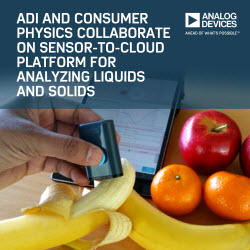

Analog Devices, Inc. (ADI) and Consumer Physics, Inc. (CP) today announced a collaboration to develop a sensor-to-cloud personal and industrial IoT platform that analyzes liquids and solids, including food, plants, drugs, chemicals, the human body, and a variety of other materials. The two companies plan to embed CP’s SCiO technology for material sensing into smartphones, wearables, industrial, and medical applications. The co-developed sensor-to-cloud platform will enable users to detect substances quickly and reliably, control quality, and measure a wide range of characteristics such as calories, fat, sugars, and proteins; sugar content or brix, in fruits and vegetables; alcohol content in beverages; and chemical composition of fuel and oil.
“ADI and CP share a vision to enable our customers to interpret the world around us,” said Martin Cotter, vice president, Internet of Things, Analog Devices. “Together we plan to make secure, reliable and robust material analysis power-efficient and affordable for use virtually everywhere in order to make the world safer and healthier.”
“We are excited to work together with ADI to embed the SCiO technology for material sensing in more applications and industries,” said Dror Sharon, chief executive officer and co-founder, Consumer Physics. “SCiO’s technology enabled the world’s first handheld molecular sensor and now there is tremendous potential to interpret the world around us not only through smart phone-embedded sensing, but also through the automotive, energy, industrial and medical applications ADI serves.”
SCiO’s underlying science is called Near-Infra-Red (NIR) Spectroscopy and has been used in laboratories around the world for decades in diverse industries such as food, pharmaceuticals, agriculture, healthcare, oil and gas, plastics, cosmetics, geology, mineralogy, and many more. Current devices are large and expensive, making them unfit for current and future IoT applications.
The physical basis underlying NIR Spectroscopy’s material analysis is based on the principle that each type of molecule vibrates in a unique way, and these vibrations interact with light to create a unique optical signature. The signature is acquired using the optical sensor and signal conditioning electronics. Advanced algorithms utilize an updatable database to analyze the spectrum and deliver information about the analyzed sample back to the user in real time.
Developer kits will be available for building custom applications. SCiO Eco-System Partners can develop smartphone and wearables experiences now using the SCiO Developer Kit, available immediately.
Integrated low-power analog peripherals reduce design costs and complexity Devices designed for capturing rapidly changing…
Healthee, the AI-powered platform transforming the health benefits experience, today announced a $50 million Series B funding…
Round led by cybersecurity visionaries SYN Ventures and YL Ventures to accelerate Miggo’s mission to…
The 2025 Cymulate Threat Exposure Validation Impact Report reveals that exposure validation significantly decreases breaches…
DigiKey, a leading global commerce distributor offering the largest selection of technical components and automation…
The round was led by the fund of Dan Caine, Chairman of the Joint Chiefs…